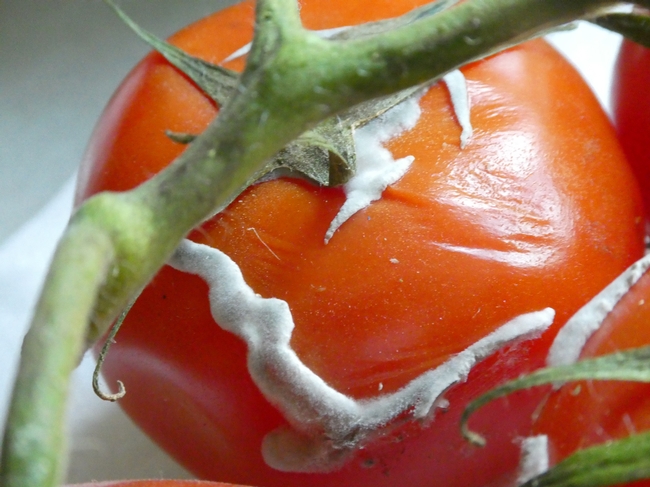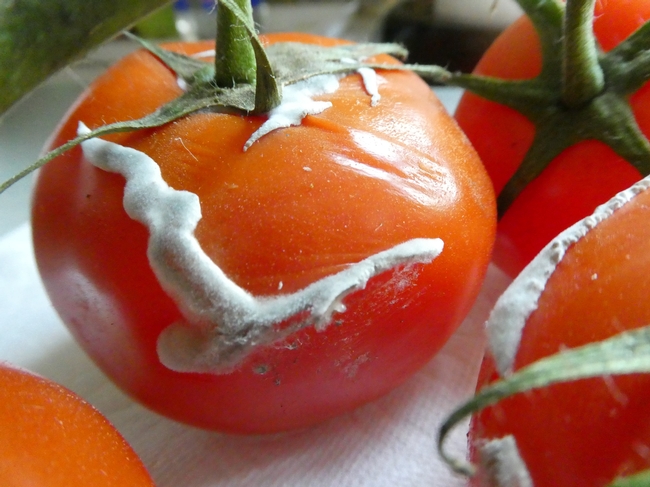Yucky White Mold on Yummy Red Tomatoes
I can't help it. I get hungry (and impatient) for the sweet taste of fresh tomatoes — especially after the last one is plucked from my backyard garden in the fall. So, I did it again. Several weeks ago, while in the produce section of the local market, I picked up a “vine-ripened” cluster of five from the pile. They smelled so good.
While cautiously scanning the aisles for anyone I knew who was a Master Gardener, I quickly plopped the five yummy red tomatoes into a plastic bag. For sure, I didn't want to deal with gardener's guilt that I couldn't wait until summer. However, what I should have scanned at the time was the body of each tomato in that bag. But who carries a magnifying glass in their pocket or drags a microscope into the grocery store? When tomatoes are marketed as vine-ripened, greenhouse grown, doesn't that mean they're comparable to what I grow in my veggie patch? Not quite.
Only one day after my purchase the evidence was clear. Those yummy red tomatoes were contaminated. And I started my search to learn exactly what I was looking at and why.
My investigation led me to several informative websites that are worth perusing.
(1) Mississippi State University's article on “Common Diseases of Tomatoes” discusses tomato diseases that occur commercially in the field and in enclosed structures leading me to conclude that where a tomato is grown is as important as how. Example: Water molds (oomycetes) are problematic concerns in Mississippi.
http://extension.msstate.edu/publications/common-diseases-tomatoes
(2) Cornell University offered a cursory overview of pathogens affecting tomatoes with photographs entitled “Tomato Disease Identification Key By Affected Plant Part: Stem and Whole Plant Symptoms.”
(2) Cornell University offered a cursory overview of pathogens affecting tomatoes with photographs entitled “Tomato Disease Identification Key By Affected Plant Part: Stem and Whole Plant Symptoms.”
(3) UCANR Pest Management Guidelines on “White Mold, Pathogen: Sclerotinia sclerotiorum” indicates this mold is airborne and soilborne, with attempts at crop resistant varieties unsuccessful to date.
http://ipm.ucanr.edu/PMG/r783101411.html
(4) Purdue University provides access to an article in PDF format, “Tomato Disease Management in Greenhouses,” addressing common diseases of greenhouse tomatoes, the importance of using a cloth ground covering between rows for easy sanitation, greenhouse ventilation with photographs of these issues.
http://ipm.ucanr.edu/PMG/r783101411.html
(4) Purdue University provides access to an article in PDF format, “Tomato Disease Management in Greenhouses,” addressing common diseases of greenhouse tomatoes, the importance of using a cloth ground covering between rows for easy sanitation, greenhouse ventilation with photographs of these issues.
Needless to say, with very limited research, my eyes opened wider to the realization that not all greenhouses are the same. As indicated in the Purdue University article, diseases that affect field tomatoes (early blight, Septoria leaf blight, bacterial spot, and bacterial canker) are less common in the greenhouse-grown crops. But those yummy red “vine-ripened greenhouse grown” tomatoes I casually purchased are not contaminant free as I certainly once thought — but come with other diseases and issues.
As for me, as a consumer, I returned my cluster of fruit to the market for them to deal with their supplier. But the topic remains an area of interest to further investigate.

photos by Launa Herrmann

White mold 2


Posted by Kathy L on June 18, 2019 at 6:01 PM